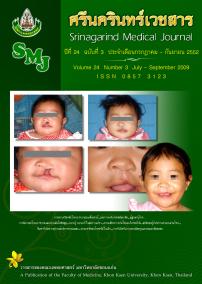ThaiScience
ThaiScience
SRINAGARIND MEDICAL JOURNAL
Volume 35, No. 01, Month JANUARY, Year 2020, Pages 51 - 58
Upper limb functions and complications of hemiplegic side in patients with chronic stroke in the community
Benjamaporn Seephim, Waroonnapa Srisoparb, Nomjit Nualnetr
Abstract Download PDF
Background and objective: Upper limb dysfunctions and complications of hemiplegic side are most common problems after stroke. However, currently no studies have been undertaken to investigate these problems in community-dwellers with stroke in Thailand. This study aimed to evaluate upper limb functions and complications of hemiplegic side in individuals with chronic stroke in a community. Methods: Participants were stroke survivors with at least 6 months post-stroke who were able to sit independently for at least 50 minutes and understand commands to perform various tests. Upper limb functions of hemiplegic side of the patients were evaluated by the Short form Fugl-Meyer Assessment Scale (S-FM) and the Streamlined Wolf Motor Function Test for chronic stroke (SWMFT-C), which each of 6 activities. Complications of the hemiplegic upper limb were identified by interviews, observations and basic physical therapy evaluations. Data were analyzed by using descriptive statistics. Results: Ninety-seven patients who were on average of 62.9±12.2 years old and 37.2±56.3 months post-stroke were recruited. Evaluations of the hemiplegic upper limb functions of the patients revealed that average scores of each activity of the S-FM and SWMFT-C ranged from 1.14 to 1.31 points (full score = 2 points) and 1.99 to 2.40 points (full score = 5 points), respectively. Additionally, the average timescale of the SWMFT-C activities ranged from 44.74 to 55.98 seconds. The two most common hemiplegic upper limb complications were shoulder pain and shoulder subluxation, following by wrist pain, muscle atrophy and hand edema. Conclusions: Community-dwellers with chronic stroke had a decrease in upper limb functions of hemiplegic side. Most of them had complications of the upper limb, particularly the shoulder joint problems. So, continuing rehabilitation after hospital discharge is necessary to enhance the recovery of upper limb in hemiplegic side.
Keywords
stroke, upper limb, communitySRINAGARIND MEDICAL JOURNAL
Published by : Faculty of Medicine, Khon Kaen University
Contributions welcome at : http://www.smj.ejnal.com/e-journal/journal/index.php
